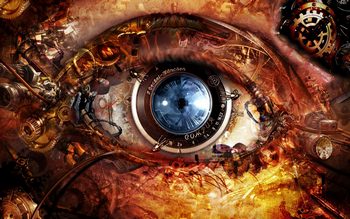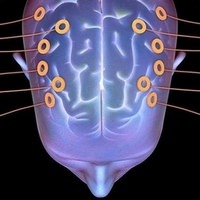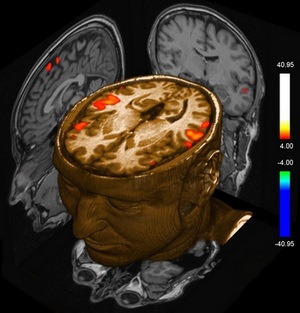Is Lucid Dreaming Real?
 It surprises me when people ask the question: is lucid dreaming real?
It surprises me when people ask the question: is lucid dreaming real?Having experienced countless lucid dreams first-hand the question seems redundant. Let alone that numerous scientific experiments have now validated the existence of lucid dreaming, with EEG measurements, fMRI studies, and good old fashioned controlled REM experiments.
So why the incredulity?
Awareness of lucid dreaming has grown significantly in the last decade - and even more so in the last two years, with a flurry of movie releases, gadgetry and apps dedicated to the subject. Yet there remain pockets of society who refuse to acknowledge its existence, and who propagate misinformation on the subject. I guess to them, the concept of dream control is so alien they just don't see it as credible at all. They must not know about the research either.
I feel it's my job to clear up this misapprehension. If there is any mystery to lucidity, it's not whether lucid dreaming is in fact possible. It's what can we use it for? How deep can we go? Are we all destined to become lucid dreamers?
Here is my Q&A addressing the most common questions and misconceptions I hear from skeptics as well as people who generally know very little about lucid dreaming. If you know anyone mouthing-off about the illusory nature of lucid dreaming, please elucidate them. Then we can all move on to the much more interesting task of discovering where our lucidity will take us...
"Is lucid dreaming real or just a theory?"
Scientists only really became interested in proving the existence of lucid dreaming in the last 40 years (see below). But prior to that, there were still lots of tantalizing references to lucid dreams throughout history. Let's start there.We can trace the concept of self-awareness in dreams through the personal records of philosophers, artists and authors over the centuries. For example, the French philosopher Rene Descartes found his lucid dreams so vivid, he concluded that our waking senses are illusory and not to be trusted.
Meanwhile, Tibetan Buddhist monks have incorporated heightened self-awareness and dream control in their path to enlightenment for at least one thousand years. The concept of conscious dreaming is widely accepted in both Eastern and Western cultures, underpinning the universal nature of this human condition which doesn't rely on any particular esoteric interpretation or spiritual belief system (unlike, say, belief in the afterlife or psychic ability).
Those who say lucid dreaming is "just a theory" need to check their definitions of what a theory is. Allow me to clarify:
- A hypothesis is a tentative explanation for an
observation or phenomenon that needs to be tested by further
investigation. It's basically an assumption which is yet to be explored
scientifically.
- A theory is the result of scientific testing, in which the reality stands up to our original assumptions. A theory is a set of statements which best explain our observations. Einstein had a couple of particularly good ones: The General Theory of Relativity and The Special Theory of Relativity.
So, theories are great! They use known observations (independent pieces of the jigsaw puzzle) to form conclusions (joining the jigsaw pieces together). The completed jigsaw is the theory. "Just a theory" means solving the puzzle as best we can and in no way should equate to belittlement of the subject at hand.
"Is lucid dreaming scientifically proven?"
 Lucidity has been scientifically documented in various forms.
Lucidity has been scientifically documented in various forms. The first time was when the British parapsychologist Keith Hearne recorded a set of pre-determined eye movement signals from his volunteer, Alan Worsley, in a lucid dream state under laboratory conditions. Worsley simply looked in different directions in his lucid dream - eg left, right, left, right, left - causing his eyeballs to mimic the action in reality. By doing this, he was able to communicate from the dreamworld to the waking world, in real time.
However, Hearne's research slipped under the radar of the mainstream science journals, and it was Dr Stephen LaBerge at Stanford University who became famous for publishing his own version of this experiment in 1983. LaBerge did his doctorate thesis on lucid dreaming and formalized some excellent lucid dream methods like the MILD technique. Today, he runs intensive workshops and dream experiments at The Lucidity Institute and his classic book Exploring The World of Lucid Dreaming remains a best-seller on the subject.
More recently, a study conducted at the Neurological Laboratory in Frankfurt in 2009 revealed significantly increased brain activity during lucid dreams. An EEG machine recorded frequencies in the 40 Hz (or Gamma) range in lucid dreamers enjoying some conscious REM. This is far greater than the normal dreamstate (Theta range, or 4-8 Hz) and perhaps more alert than you are right now (Beta range, or 12-38 Hz). They also saw heightened activity in the frontal and frontolateral areas of the brain which are the seat of linguistic thought as well as other higher mental functions associated with self-awareness.
From these two experiments alone we can conclude that:
- We can control our dreams. Lucid
dreaming offers the ability to remember waking commands and act
willfully when conscious within the dream state, in this case with
pre-determined eye movements.
- We can achieve consciousness in dreams. Lucid dreaming produces a highly active brainwave frequency not associated with regular dreaming or even normal waking awareness, in this case up to 40 Hz.
"How can you prove to me that you're actually controlling your dreams?"
Keith Hearne's original Rapid Eye Movement experiment was an excellent way to prove that lucid dreaming is real because it allowed the lucid dreamer to communicate in real-time with the researcher in the waking world. The experimental method was scientifically verified and is about as close as you can get when it comes to proving you have conscious dream control.Unfortunately, it's very difficult to prove the content of our dreams. It's like saying: "prove to me that you're thinking of the color red". You can describe the color and assure us you're thinking about it, but thoughts (like dreams) are a subjective experience and can't be transferred to the mind of someone else, nor directly recorded without going through some creative filter.
This is why all other serious experimental research has turned to the next best thing - measuring brain activity during sleep. A number of new studies have focused on EEG which measures brainwaves and fMRI which measures blood flow in the brain. Despite the obvious difficulties of falling asleep and then becoming lucid inside an fMRI machine, lucid dreamers have done it. That's a feat in itself.
 One
study by the Max Planck Institute saw lucid dreamers clench their right
fist in their dream for 10 seconds. Then they clenched their left fist.
At the same time, fMRI scans revealed which parts of their brains were
active during this act. Amazingly, the same areas of the brain were
activated on performing the same fist-clenching task in a waking state.
One
study by the Max Planck Institute saw lucid dreamers clench their right
fist in their dream for 10 seconds. Then they clenched their left fist.
At the same time, fMRI scans revealed which parts of their brains were
active during this act. Amazingly, the same areas of the brain were
activated on performing the same fist-clenching task in a waking state.Now, the purpose of the study was not to prove lucid dreaming scientifically - that has already been done - but instead to create a database of dream signals and their associated brain activity. It may be a few years off but, in time, a brain scan could reveal the exact content of our dreams, without actually "seeing" them. Other scientists are already working on the dream playback technology.
When people remain in doubt, I challenge them to experience the lucid dream state first-hand - and then prove to themselves what is possible. When you become lucid, you will immediately understand the potential for dream control. With many different lucid dream induction techniques at your fingertips there is no excuse NOT to try if you are curious about the nature of lucidity. It is the only way you'll truly understand what a conscious dream feels like anyway.
Incidentally, when scientists invent the first mutual dream machine (a la Inception) I'll gladly invite readers into my own lucid dream world so I can demonstrate the power of self-awareness in dreams.
"If you're not controlling every element of the dream, then surely you aren't lucid dreaming?"
This is a common misconception. To lucid dream does not mean to be 100% in control of the dreamworld. Lucid dreaming only means to have conscious self-awareness within the dream state. Sometimes this means controlling it, but other times you will choose to simply observe the dreamworld while holding on to the clarity of thought enabled by your heightened awareness.As the lucid dream researcher Robert Waggoner so eloquently put it: "The sailor does not control the sea." In other words, your consciousness is the ship that navigates through a subconscious ocean. If you truly had to populate every dream scene with every leaf and blade of grass and wisp of cloud, you would have your hands full just creating and maintaining decent scenery!
Luckily, the dreaming subconscious is happy to populate the dreamworld while we consciously frolic within it. Sometimes that means a bird flies of its own accord, or a dream figure behaves autonomously. That does not mean you have failed to stay lucid. You are still very much directing your awareness.

Non-lucid dreamers may think there's no point to lucid dreaming if you don't always have control of the dream - but to lucid dreamers, the benefits are clear. The sheer detail of a lucid dream can be enough to leave you dumbfounded and happy to watch the dream unfurl naturally in your super-sensory state.
What's more, the fact that you have the opportunity to directly interact with your own subconscious dreaming self makes it all the more exciting. When have you EVER been in direct contact with your unconscious mind before? Visualization, hypnosis - and even deep meditation - may pale in comparision to the types of experiences generated by fully lucid dreams.
In the best-selling Lucid Dreaming: Gateway to the Inner Self, Robert Waggoner suggests we talk to a dream figure, or even shout out a question to the dream itself. We'll be rewarded with the wisdom of our own inner voice which plays out its answer within the dream. This alone can be more exhilarating than any controlled dream experience based on the desire to seek out the physical thrills of a virtual reality world. Oh yes, lucid dreams are profound indeed.
"If lucid dreaming is so real, how can you tell the difference between lucid dreams and reality?"
The main reason is because you have self-awareness. This is the crux of everything. Indeed, in non-lucid dreams, you have no self-awareness and the result of that is you accept the dreamworld as reality. You go along with it, even if it's totally surreal. So the "realness" of a lucid dream does not stop us from realizing we're dreaming. On the contrary, the realness is a side-effect of self-awareness, and this allows us to make the distinction clearly. But how, exactly? Well, there could be many telltale signs but ultimately you know you're dreaming simply because you know you're dreaming!
But how, exactly? Well, there could be many telltale signs but ultimately you know you're dreaming simply because you know you're dreaming! Right now, reading this screen, you are self-aware. You are using your five senses to build up an accurate picture of your surroundings and that keeps you rooted in reality. There is no doubt in your mind that you are awake right now.
A similar process of logic occurs when you become lucid. Often it is a spontaneous realization that something in your dream reality is amiss. Perhaps you have seen something strange, or heard something out of the ordinary. This triggers a far heightened sense of self-awareness in the dreamworld which enables you to fully question your reality and verify that you are, in fact, dreaming.
How you do you know when you're thirsty? You feel a dryness in your throat. How do you know when you're scared? You feel a flurry of adrenaline. How you you know when you're dreaming? You feel your reality has changed. To become conscious in a dream is simply to become more aware of your surroundings.
For most lucid dreamers, the inability to separate dreams from real life only rears its head in the bizarre limbo-like state of a false awakening. This is where you dream of waking up and accept it as your waking reality. An alternate type of lucid dream, based heavily on your reality, it lodges you in a logical loop where you become unable to recognize that you're dreaming. The only "escape" is to perform one - or sometimes several - effective reality checks before you can turn your false awakening into a lucid dream.
However, there is nothing dangerous about false awakenings. You either finally recognize you're dreaming and become lucid - or you wake up for real. Multiple false awakenings can be disturbing at the time but they are otherwise harmless vivid dreams, the kind of which we've all had before.
"Are there any limits to lucid dreaming?"
So far the only limits I have found are self-imposed ones.
For instance, it's quite common for beginners
to struggle to maintain their lucidity for more than a few seconds. The
whole experience is far too exhilarating and they wake up.
However, there is a steep learning curve and
with a little practice, lucid dreams can last 10-20 minutes -- and
occasionally up to an hour. Even a short lucid dream can make your week,
though, so don't feel you have to be an expert oneironaut before you
reap the rewards. For many, a lucid dream is immensely exhilarating the
very moment you become lucid, so that even a 7-second lucid dream
becomes a talking point the next day.
Another frustrating limitation for newbies is
the act of dream control. Many people start lucid dreaming in order to
fly or have sex, and so they must master dream control to fulfil their
need for physical gratification. However, they soon find that flying can
be difficult (it contradicts known laws of reality) or finding a sexual
partner is impossible (the subconscious has a different agenda) and
this ultimately leads to frustration.
A far more worthwhile pursuit, then, is to
learn everything you can about the conscious dream state as an intrepid
explorer. Simply enjoy the experience for what it is. You will still
enjoy many rewarding experiences and have the chance to uncover
fascinating insights that will stay with you forever.
